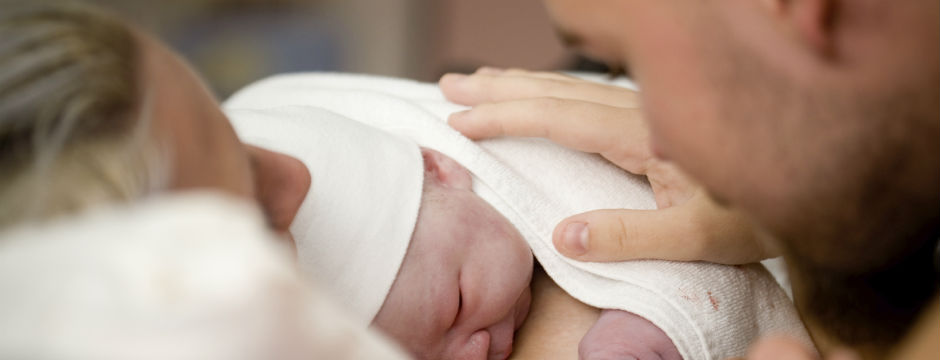You’ve finalized your birth plan and gone into labor. Delivery is the final stage of every pregnancy. You might not be in the hospital yet, but your baby is definitely preparing to meet the world. So what should you expect?
Stages of Delivery
Stage 1: Latent Phase
This is the longest and least intense phase in your delivery. Contractions will become more frequent which is helping your cervix to dilate so that your baby can pass through the birth canal. During this phase your cervix will dilate approximately 3 or 4 centimeters. If your contractions are regular, you will probably be admitted to the hospital during this stage.
What helps: Take time to settle down and work with the labor. Alternate rest and activity, eat easily digested foods and drink plenty of fluids. When your contractions become so strong that you cannot talk yourself through them, try using relaxation and breathing strategies. Keep the environment pleasant – listen to music, ask your partner for a shoulder massage or prepare the baby’s room.
Stage 2: Active Phase
Your cervix is dilated anywhere from 4 to 7 centimeters during this phase. You will feel intense pain or pressure in your lower back or abdomen during each contraction. You will want to push or bear down but your doctor will ask you to wait until your cervix is completely open.
What helps: Listen to your body and develop a rhythm with it. Do something between contractions such as breathing in a pattern or moving around. Change positions frequently to help you stay comfortable and enhance the progress.
Stage 3: Transition Phase
The cervix is fully dilated at 10 centimeters during this phase. Contractions are very strong, painful, and frequent – about every three to four minutes lasting from 60 to 90 seconds.
What helps: Focus on one contraction at a time to keep from feeling overwhelmed. Relax and restore yourself during the short rest periods.
Stage 4: Pushing
Once your cervix is completely opened, your doctor will give you the OK to push. The pushing and contractions will propel your baby through the birth canal. The fontanels, or soft spots, on your baby’s head allow it to fit through the narrow canal. The baby’s head crowns when the widest part of it reaches the vaginal opening.
Once the baby’s head comes out, your doctor will suction amniotic fluid, blood, and mucus from his or her nose and mouth. You will continue to push to help deliver the baby’s shoulders and body. After the baby has been delivered the umbilical cord is clamped and cut.
What helps: Just follow along and do what feels right. It may help to make sounds in response to what you’re feeling. If progress is slow, change positions. Squatting, all-fours and side-lying are all good options. Rest deeply between contractions.
Stage 5: Placenta
After your baby is delivered you enter the final stage of labor when you deliver the placenta, the organ that nourished your baby inside the womb. Each woman experiences labor differently.
Labor and delivery usually lasts about 12 to 14 hours.
What to Expect After Delivery
You may be experiencing some physical changes such as:
Pain at the episiotomy site
An episiotomy is the cut made by your doctor in the area between the vagina and the anus to help deliver the baby or prevent tearing. If this was done, or the area was torn during birth, the stitches make walking or sitting difficult. If could be painful when you cough or sneeze during healing time.
Excess water weight
You will still be carrying excess weight in the first 24 hours, most of which is water. You’ll start to shed this water weight within a week after delivery, so prepare for plenty of peeing and perspiring.
Sore breasts
Your breasts may be swollen, hard, and painful for several days as your milk comes in. Your nipples may also be sore.
Hemorrhoids
Hemorrhoids happen when the varicose veins in the anal area are swollen. They are common after pregnancy and delivery.
Constipation
Having a bowel movement may be difficult for a few days after delivery. Hemorrhoids, episiotomies and sore muscles can cause pain with bowel movements.
Hot and cold flashes
Your body is adjusting to changing levels of hormones and blood flow after delivery, which can cause you to perspire one minute and reach for a blanket the next.
Urination or fecal incontinence
The muscles that were stretched during delivery, particularly after a long labor, may cause you to leak urine when you laugh or sneeze. It may make it difficult to control bowel movements.
After pains
After giving birth, you will continue to experience contractions for a few days as your uterus returns to its pre-pregnancy size.
Vaginal discharge
Immediately following birth you will experience a bloody discharge heavier than a regular period. Over time the discharge will fade to a white or yellow color and then stop entirely within two months.
Emotional Effects
Emotionally you may experience irritability, sadness, or crying, commonly referred to as the “baby blues,” in the days or weeks after delivery. These symptoms occur in up to 80% of new mothers and may be related to physical changes.
If your problems persist, inform your doctor or other health professional; you could be experiencing postpartum depression, a more serious problem that affects between 10% and 25% of new mothers.

